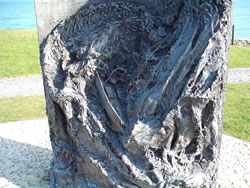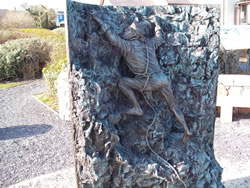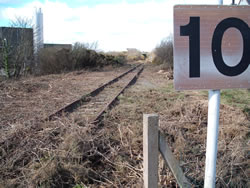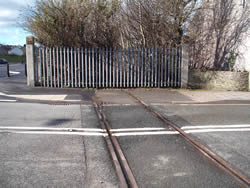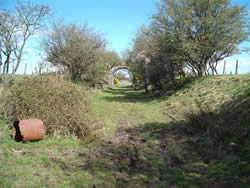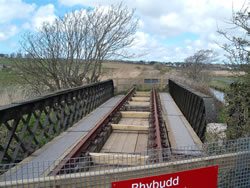The Royal Charter
On 27 October 1859, the clipper Royal Charter was wrecked within yards of land off Moelfre, with the loss of over 400 people. It was a tragic end to a voyage that had started in Australia on 26 August 1859, with many of its passengers returning with gold mined from Australian gold fields. The ship was a veritable bullion ship, and its passengers will have harboured high hopes for a more comfortable life following their return to Britain. It was not to be, as the Royal Charter never made it back to Liverpool.
In 1855, the Royal Charter was built at Sandycroft on the River Dee. She was a hybrid vessel, using both sails and an auxiliary steam engine. In her short life, she earned a reputation as being the fastest passenger liner of her day, but her day was not to last long. Her hull was built of iron as opposed to wood, and this was thought to give her additional strength.
In 1859, just four years after she was launched, the Royal Charter was nearing the end of its voyage from Australia to Liverpool when it ran into a huge storm and was wrecked within sight of land at Moelfre. Fewer than 50 people survived, and more than 400 people died in the tragedy.
The Royal Charter was wrecked simply because it had the misfortune to encounter a storm of immense severity at a time when it was so close to land, that there was little if any room for manoeuvre. Indeed, when it finally grounded, the Royal Charter was estimated to be less than 25 yards from land at Moelfre. The fact that so few were saved in itself gives an indication of the extreme conditions experienced on the night of what became known as the Royal Charter gale.
Some insight into the aftermath of the tragedy may be gained from the writings of Charles Dickens, who visited Moelfre a few weeks after the shipwreck, and wrote of his visit in his book, The Uncommercial Traveller,
"Even as I stood on the beach with the words ‘Here she went down!’ in my ears, a diver in his grotesque dress, dipped heavily over the side of the boat alongside the Lighter, and dropped to the bottom. On the shore by the water’s edge, was a rough tent, made of fragments of wreck, where other divers and workmen sheltered themselves, and where they had kept Christmas-day with rum and roast beef, to the destruction of their frail chimney. Cast up among the stones and boulders of the beach, were great spars of the lost vessel, and masses of iron twisted by the fury of the sea into the strangest forms. The timber was already bleached and iron rusted, and even these objects did no violence to the prevailing air the whole scene wore, of having been exactly the same for years and years.
Yet, only two short months had gone, since a man, living on the nearest hill-top overlooking the sea, being blown out of bed at about daybreak by the wind that had begun to strip his roof off, and getting upon a ladder with his nearest neighbour to construct some temporary device for keeping his house over his head, saw from the ladder’s elevation as he looked down by chance towards the shore, some dark troubled object close in with the land. And he and the other, descending to the beach, and finding the sea mercilessly beating over a great broken ship, had clambered up the stony ways, like staircases without stairs, on which the wild village hangs in little clusters, as fruit hangs on boughs, and had given the alarm. And so, over the hill-slopes, and past the waterfall, and down the gullies where the land drains off into the ocean, the scattered quarrymen and fishermen inhabiting that part of Wales had come running to the dismal sight—their clergyman among them. And as they stood in the leaden morning, stricken with pity, leaning hard against the wind, their breath and vision often failing as the sleet and spray rushed at them from the ever forming and dissolving mountains of sea, and as the wool which was a part of the vessel’s cargo blew in with the salt foam and remained upon the land when the foam melted, they saw the ship’s life-boat put off from one of the heaps of wreck; and first, there were three men in her, and in a moment she capsized, and there were but two; and again, she was struck by a vast mass of water, and there was but one; and again, she was thrown bottom upward, and that one, with his arm struck through the broken planks and waving as if for the help that could never reach him, went down into the deep."
One positive outcome of the tragedy concerned the then experimental government department which had been set up in 1854 to research the possibility of forecasting weather conditions. The Royal Charter tragedy emphasised the need for such a department, which exists to this day and is now known as the Met. Office. Shipping forecasts are broadcast on longwave and FM radio by the BBC four times a day.
Railways of Anglesey
The main railway line serving Anglesey crosses the Menai Straits on the re-modelled Britannia Bridge, before arriving at the first station, Llanfairpwll. After this station, the route is striking in that it avoids the larger towns and villages, taking a curving route along the western side of the island before terminating at Holyhead. This route was borne out of a need to create a fast link between London and Dublin, and the potential revenue from local passengers was therefore a secondary consideration.
Aside from Holyhead and Llanfairpwll, there are intermediate stations at Gaerwen, Bodorgan, Ty Croes, Rhosneigr, and Valley, although some of these are request stops only.
Anglesey Railway History
Ambitious plans for railways across Anglesey reflected the growth in railways in the second half of the nineteenth century, but very few of the schemes came to fruition. The main line described above was a certainty because of the need to meet the increasing traffic between England and Ireland. Other schemes involved lines across the centre of Anglesey. through Llangefni to Amlwch, and then around to Cemaes Bay. A branch line was also proposed from Holland Arms to the east coast at Benllech. Other plans which failed to materialise included Valley to Cemaes, Cemaes to Rhosgoch, and Menai Bridge to Beaumaris.
The central section was constructed as far as Amlwch, but the link through to Cemaes Bay was never started. The branch line to Benllech fared better inasmuch as it was built as far as Red Wharf Bay, but the line was unprofitable, and passenger traffic ceased in 1950. Little now remains of the infrastructure, aside from some redundant bridges, including one which is visible from the A5025 road at Pentraeth.
Anglesey Railway Preservation
Anglesey Central Railway Company Ltd (Lein Amlwch) is aiming to re-open part of the former Anglesey Central Railway, which ran 15 miles from the mainline junction at Gaerwen to Amlwch. The Beeching Report led to the closure of the line to passenger traffic in 1964, although special passenger trains ran in 1992 and 1994, courtesy of Isle of Anglesey Railways Ltd. Freight traffic from the Octel Works in Amlwch continued until 1993.
The potential for re-opening is greater because the track was never removed, and when the A55 Expressway was built across Anglesey in 2000, the line was bridged just north of Pentre Berw.
Welsh Language
Why not try some of the phrases suggested here?
- Good morning - Bore da (Boreh daa)
- Good afternoon - Prynhawn da (Prin houn da)
- Good evening - Noswaith dda (Nos whyth thaa)
- Thank you - Diolch yn fawr (Dee-ohlch uhn vowrr)
- How are you? - Sut dach chi? (Sit dac hi)
- Fine, thank you - Iawn, diolch yn fawr (yaoon, dee-ohlch uhn vowrr)
Wales has its own Welsh language television station, S4C, or Sianel Pedwar Cymru. Its website, www.s4c.cymru/en/dysgu-cymraeg, has extensive resources for learners at every level.
What about the Welsh names for English places and place-names?
| Welsh | English |
|---|---|
| Cymru | Wales |
| Lloegr | England |
| Iwerddon | Ireland |
| Yr Alban | Scotland |
| Bryste | Bristol |
| Caeredin | Edinburgh |
| Caergaint | Canterbury |
| Caergrawnt | Cambridge |
| Caerlleon Fawr | Chester |
| Castellnewydd | Newcastle |
| Efrog | York |
| Henffordd | Hereford |
| Lerpwl | Liverpool |
| Llundain | London |
| Manceinion | Manchester |
| Rhydychen | Oxford |
| Yr Amwythig | Shrewsbury |
| Y Trallwng | Welshpool |
Welsh place names often reflect some natural feature of the settlement, and the following will be seen, not only on Anglesey, but in a number of places in Wales:
| Welsh | English | Examples on Anglesey |
|---|---|---|
| aber | river mouth | Aberffraw |
| afon | river | |
| bryn | hill | Brynsiencyn |
| bychan | small | Traeth Bychan |
| carreg | stone | Carreglwyd |
| cefn | ridge | Rhoscefnhir |
| coed | trees or wood | Coedana |
| creigiau | rocks | Pencraigwen |
| croes | cross | Ty Croes |
| din | fort | Din Lligwy |
| ffordd | road or way | Bodffordd |
| gwyn | white | Plas Gwyn |
| llannerch | glade or clearing | Llanerch-y-medd |
| llyn | lake | Llyn Maelog |
| marian | stoney ground | Marianglas |
| melin | mill | Pentrefelin |
| mynydd | mountain | Penmynydd |
| nant | valley | Nant y Pandy |
| pen | head of | Penmynydd |
| pont | bridge | Pontrhydybont |
| porth | gateway or harbour | Porthaethwy |
| rhos | moorland | Rhosybol |
| traeth | beach | Traeth Bychan |
| ty | house | Ty Croes |
| ynys | island | Ynys Môn |
Contact Us
We set up this site because we wanted to share the essence of Anglesey with other like-minded people, and also with those who would like to know a little more about this magical island, perhaps with a view to becoming Anglesonians.
We certainly welcome any comments and suggestions about this website.
Unless otherwise stated, all photographs are copyright of the website. Larger versions of our photographs can be obtained by clicking on them.
Are there any areas which you would like to see on the site? Let us know your views and we will see if we can assist.
Perhaps there are parts of the website that are not working. If so, then please email us and we will look into it.
If you would like to help to translate pages into Welsh, then we would be very pleased to hear from you.
Also, if you run a business or are considering starting one here on Anglesey, and would like to advertise on this site, then please email us.
Our email address is

